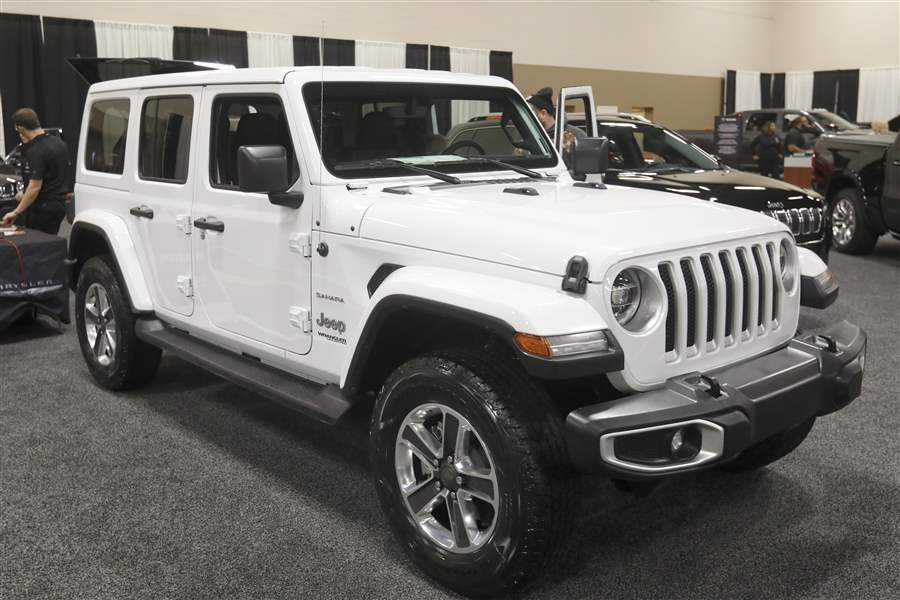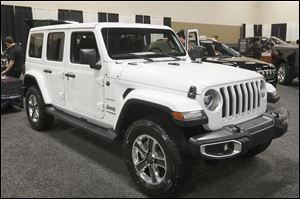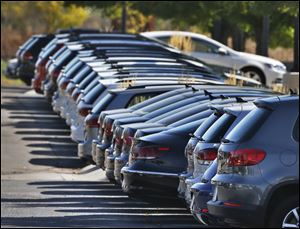
Jeep revs up while overall auto industry slips
3/2/2018
A 2018 Jeep Wrangler on display at the Greater Toledo Auto Show in February. Fiat Chrysler said sales of the Wrangler in February were up 17 percent from the same month in 2017.
The Blade/Katie Rausch
Buy This Image
The Jeep brand soared in what was an otherwise uninspiring February for the U.S. auto industry, helped in part by dealers getting their hands on more of the all-new Jeep Wrangler.
Jeep parent company Fiat Chrysler Automobiles said Thursday it sold 15,936 Wranglers last month, a 17 percent increase over the prior year and a new record for February. It’s impossible to know how many of those Wranglers were the new JL-generation model, which FCA began delivering in January — the company won’t say — but dealers are beginning to see the number of new Wranglers they’re receiving tick upward.
“We’ve had a good steady supply of the JLs coming in,” said Doug Kearns, vice president of the Yark Automotive Group. “I think once they got through their quality hold, just going through all the vehicles and making sure everything was perfect, and they started to release them, we’ve had a good flow of them coming in.”

A 2018 Jeep Wrangler on display at the Greater Toledo Auto Show in February. Fiat Chrysler said sales of the Wrangler in February were up 17 percent from the same month in 2017.
Mr. Kearns said Yark’s FCA franchise sold 41 Wranglers last month, including 11 of the new Wrangler. Most of those went to buyers who had already put in orders.
Both the JK-generation Wrangler and the new JL-generation Wrangler are made exclusively in Toledo at Fiat Chrysler’s Toledo Assembly Complex, though production of the outgoing model is expected to draw to a close in early April. Eventually, the Toledo plant will build a new Jeep pickup truck.
Industrywide, sales slipped 2.4 percent in February, according to Autodata Corp. — the third straight month of lower year-over-year sales. Of the six largest automakers by sales in the United States, only Toyota was up over last year. Sales for the Japanese automaker were up 5 percent, thanks largely to a strong month from Toyota’s pickup trucks as well as the Camry and RAV4.
Subaru, Mazda, and Volkswagen also reported higher year-over-year sales last month.
Despite the Toyota Camry’s success, the market for sedans continues to cool, while the still-hot crossover segment is getting evermore crowded.
“It’s getting more competitive because the pie is shrinking this year. It shrunk last year. It’s going to shrink some more this year,” said Michelle Krebs, executive analyst for Autotrader. “We think the total for the year will be 16.7 million [units], so everybody is really competitive for getting their slice of it.”
Also challenging the new car market is the number of vehicles coming in off leases. While that inventory has been slowly increasing, analysts say this year will see a more significant number of crossovers being turned back in, giving buyers who are in the market for those types of vehicles more used options than they’ve had the last few years.

Car sales nationwide slipped in February, continuing a trend, according to Autodata Corp.
“The mix this year is richer in utilities. That gives more budget-minded consumers an option,” Ms. Krebs said.
If Autotrader’s forecast for 2018 proves correct, that would represent a decrease of about 3 percent from last year. Even so, that’s still a historically high number and the industry can be plenty profitable selling 16.7 million new cars and trucks — particularly as average transaction prices hover around record levels.
Kelley Blue Book said the industry’s average transaction price was $35,444, down slightly from January but up several hundred dollars from the prior year.
Among the largest automakers, General Motors and Ford reported the biggest decline, with each reporting sales sinking 7 percent compared to last year. Honda saw sales slip 5 percent, while Nissan was down 4 percent. Fiat Chrysler sales were down a little more than 1 percent.
Analysts say we can anticipate more months like February as the year rolls on.
“There are, however, indications that incentive activity has eased a bit, reflecting automaker discipline and industry understanding of the situation. Also, the impact of the recent tax changes has not quite filtered through to consumer behavior,” said Stephanie Brinley, senior automotive analyst at IHS Markit. “Consumers may be a bit on the fence, delaying a purchase as they evaluate the benefit of the changes to their income. The story relative to slowing demand for cars and strong demand for utility vehicles continues to underlie results.”
Contact Tyrel Linkhorn at tlinkhorn@theblade.com, 419-724-6134, or on Twitter @TyrelLinkhorn.